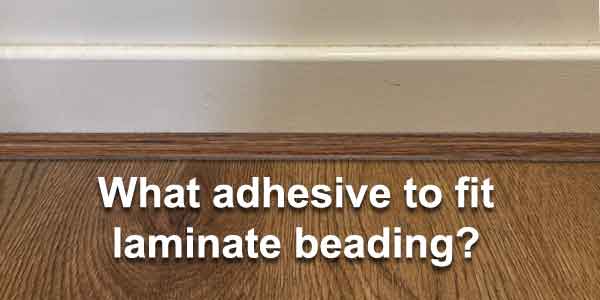Laminate is a popular choice of flooring and is probably the most common alternative to carpets. Once fitted, it provides an attractive, low maintenance alternative to a carpeted floor.
The installation is relatively easy and in most cases it can be done as a DIY project. However, there is a chance you will need to cover gaps where your laminate meets the skirting board. This can be done with beading.
Laminate beading can be attached with an adhesive, such as no more nails. However, fixing with actual nails is a better option. Something like 20-25mm lost head nails, can be used if you are fixing manually. If you do own a finishing nail gun, this would be the easiest option, for this you would use 25mm finishing nails.

One adhesive that is recommended, whichever way you fix your beading, is some kind of mitre adhesive. These are a type of fast setting adhesive that consist of a glue and an activator spray.
This type of adhesive should be used on all internal and external mitres. It will ensure that your mitres are tight, without any gaps. It will also enable you to create neater, more seamless mitres, where there is no step or uneven joints. A good option for this type of adhesive is Mitre Fast. You can read more about Mitre Fast and read reviews by clicking here
When would you need laminate beading
If you are running your laminate under the skirting board (which is preferable), then there is a good chance you won’t need beading. This is because the skirting will sit on top of the flooring, which should result in no gap, and a nice, neat finish.
However, in some cases a gap will be unavoidable. For example, if you are fitting your laminate after the skirting is installed, you will definitely need to add some beading. This is quite common if you are removing carpets and replacing with laminate.
The reason for this, is your skirting will already be sat on the floorboards. Therefore you can’t run the laminate underneath unless you remove the skirting.
If you decide to lay the flooring without removing skirting boards, you will need to leave an expansion gap between the laminate and the skirting. This gap will be around 10mm, so it will be very noticeable without any beading.
This is not something you could just leave, as it wouldn’t look good, and it would also allow dirt to get into the gap between your skirting and flooring.
In this case, a bead would cover the expansion gap and give a neat finish. The beading is attached to the skirting, not the floor. This means the expansion gap will be free to move whilst hidden by the bead. Essentially, it enables the floor to expand and contract, with changes in humidity and temperature.
Having a bead is definitely not as neat as fitting skirting on top of your flooring. However, it does still give a very nice finish. Beading will usually match the flooring, which makes it less obvious. Or it can be painted white to match skirting boards.
Also, beading comes in several different styles. Probably the most popular are scotia and quadrant.
Times when you may want to use an adhesive
As we mentioned previously, nailing the beading is the most common method of fixing it in place. With that said, there are situations where you may want a completely seamless finish.
This would mean no nail holes in the bead. In this scenario, using an adhesive such as no more nails, would be a good solution. Just like when you fit with nails, this type of adhesive shouldn’t stick the beading to the floor. Instead it should fix it to the skirting. This will leave your expansion gap to move freely.
In order to get a solid fixing that is tight back to the skirting, you should wedge the beading back with something heavy as the adhesive goes off. This will ensure a good strong fixing, and no gap.
Whether you are nailing or using an adhesive, you should still be using some kind of mitre glue. This is recommended for both internal and external mitres. As well as any other areas where you are joining two pieces of bead together.
How to avoid using laminate beading all together
In an ideal world, you wouldn’t use a beading at all. The best way to fit laminate flooring is to have it running under your skirting, architrave, and door frames.
If there are no skirting boards attached, then you can simply lay the flooring to the walls. Again you would need to leave an expansion gap, but this would get covered by the skirting boards.
If you already have skirting boards installed, but you don’t want to finish your floor with beading, then you only really have one option. You will need to remove the skirting boards, and re-attach once the flooring is installed.
You may also need to shorten architrave and door casings. However, this can usually be done in situ, without removing them.
To do this you will need an oscillating multi-tool, and you can use an off-cut of flooring to ensure you are cutting the right amount.
Conclusion
You can use an adhesive for beading on laminate flooring, but the most common way to fit them is with nails. This will generally give a better fixing. However, something like no more nails will give a solid bond, it will just need holding in place as the adhesive dries.
One type of adhesive you will always want to use, is some sort of glue on the mitres. You can use standard wood glue for this. However a two-part mitre adhesive will do a far better job.




